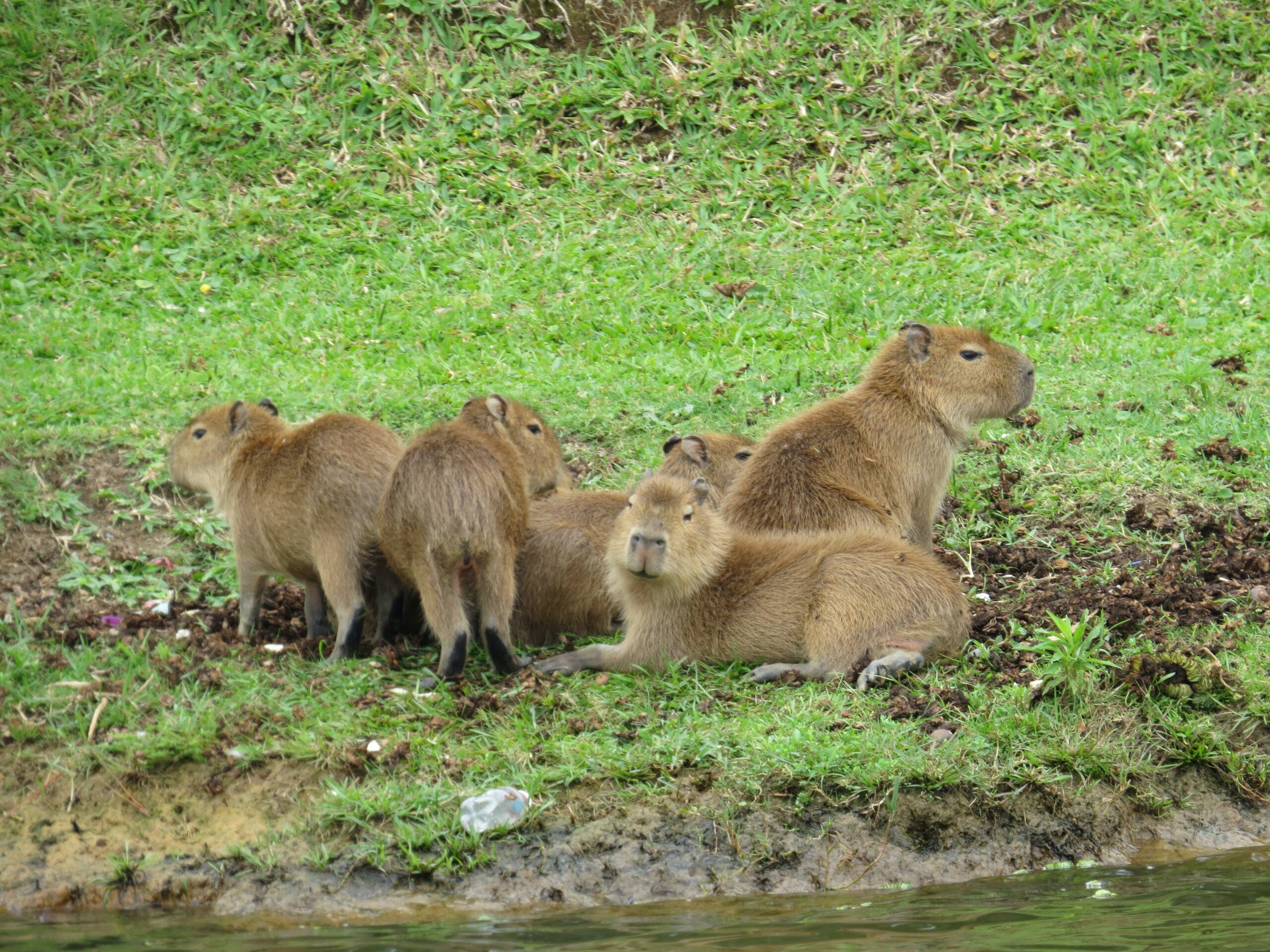Imagine coming across a creature that looks like a mix between a giant guinea pig and a miniature hippo. Meet the capybara, the largest rodent in the world. With its adorable face and remarkable size, the capybara has fascinated scientists and animal enthusiasts alike. This fascinating creature is not just a cute face; it boasts some truly impressive qualities that make it a unique and captivating addition to the animal kingdom. In this article, we will dive into the intriguing world of the capybara, exploring its extraordinary characteristics and shedding light on why it deserves our attention.

1. Physical Characteristics
Capybaras are the largest rodents in the world and can grow to be quite large, measuring around 4 feet in length and weighing up to 150 pounds. Despite their size, they have a compact and stout shape, resembling a large guinea pig. Their bodies are covered in short, coarse fur that can range in color from reddish-brown to dark brown. This fur helps keep them insulated and protected from the elements.
Capybaras have unique feet that are specifically adapted for their semi-aquatic lifestyle. Their feet are partially webbed, allowing them to navigate through water with ease. They also have sharp claws that enable them to grip and dig into the ground while foraging or socializing. Additionally, their tails are relatively short, measuring about one-fourth of their body length and are used for balance while swimming.
2. Natural Habitat
2.1 Geographic Distribution
Capybaras are native to South America and can be found throughout a wide range of countries, including Brazil, Venezuela, Colombia, and Argentina. They primarily inhabit areas with abundant water sources, such as rivers, marshes, and ponds.
2.2 Aquatic Environments
Capybaras are well-suited to aquatic environments and are excellent swimmers. They have adapted to a semi-aquatic lifestyle and spend a significant amount of time in the water, often using it as protection from predators. They are capable of completely submerging themselves, with only their noses and eyes poking above the water’s surface.
2.3 Land Habitats
While capybaras are mainly found near water, they also venture onto land to graze on grasses and other plants. They prefer grassy areas adjacent to water bodies, such as riverbanks or lake shores. These areas offer them a convenient food source as well as a quick escape route back into the water if they feel threatened.
3. Social Behavior
3.1 Family Groups
Capybaras are highly social animals and live in large groups known as herds or colonies. These groups typically consist of 10 to 30 individuals and are led by an alpha male and female. Within the herd, there is a complex social structure, and individuals form close bonds with one another. This social structure provides protection from predators and ensures the well-being of the group as a whole.
3.2 Communication
Communication plays a vital role in capybara society. They use a variety of vocalizations, including whistles, chirps, and purrs, to convey messages to other members of the herd. Additionally, they communicate through scent marking, which involves leaving their musk on plants or objects to define territory or attract potential mates.
3.3 Mating
Capybaras are monogamous animals, meaning they mate for life. The alpha male and female are the only ones in the group that breed, while the other members help in raising the offspring. The gestation period for capybaras is around 150 days, after which the female gives birth to a litter of usually four to five young, called pups. These pups are born fully furred and with their eyes open, allowing them to quickly adapt to their surroundings.
3.4 Grooming
Grooming is an essential aspect of capybara social behavior. They engage in mutual grooming, where individuals use their teeth to clean and groom each other’s fur. This not only helps keep their fur clean and free from pests but also strengthens social bonds within the group.
4. Diet and Feeding Habits
4.1 Herbivorous Diet
Capybaras are herbivores, meaning they primarily feed on vegetation. Their diet consists mainly of grasses, aquatic plants, and various types of fruits and vegetables. They have large front incisor teeth that are continuously growing, which allows them to efficiently chew and graze on their plant-based diet.
4.2 Grazing Behavior
Capybaras are opportunistic grazers, meaning they feed on a variety of plants available in their habitat. They have a unique feeding behavior where they sit on their hind legs to reach higher vegetation. This posture enables them to feed on both grasses and leaves from shrubs and trees.
4.3 Coprophagy
One interesting feeding habit of capybaras is coprophagy, which involves consuming their own feces. While it may seem strange, this behavior is vital for their digestion. Capybaras have a specialized digestive system that allows them to extract maximum nutritional value from their food. By eating their feces, they can further break down plant matter and extract any remaining nutrients that may have been missed during the initial digestion process.

5. Adaptations for Survival
5.1 Ability to Swim
Capybaras have adapted to their semi-aquatic lifestyle by developing excellent swimming abilities. Their partially webbed feet, along with their streamlined bodies, enable them to move effortlessly through the water. They can navigate rivers, lakes, and ponds with ease, allowing them to escape from predators or explore new areas for foraging.
5.2 Webbed Feet
The partially webbed feet of capybaras serve multiple purposes. Besides aiding in swimming, their webbed feet also make them efficient on land. The webbing acts as a natural snowshoe, distributing their weight more evenly and preventing them from sinking into soft or muddy terrain. This adaptation allows them to move swiftly and efficiently on both land and in the water.
5.3 Eyes and Ears
Capybaras have eyes and ears that are strategically positioned on the tops of their heads, allowing them to remain alert and vigilant even while partially submerged in the water. This arrangement enables them to spot potential predators or other threats from a distance, giving them an advantage in detecting danger and ensuring their survival.
5.4 Nose and Whiskers
The nose and whiskers of capybaras provide them with special sensory adaptations. Capybaras have large, mobile noses that are capable of detecting scents in the environment. This keen sense of smell helps them locate food sources and identify potential predators or threats. Additionally, their long whiskers are highly sensitive and assist in navigating their surroundings, particularly in low-light conditions.
6. Predators
6.1 Natural Predators
Despite their large size and formidable adaptations, capybaras have several natural predators in their native habitats. Jaguars, caimans, and anacondas are among the most significant threats to capybaras. These predators use stealth, speed, and their own unique adaptations to hunt and capture capybaras, particularly when they are vulnerable on land.
6.2 Defense Mechanisms
Capybaras have developed various defense mechanisms to protect themselves from predators. When threatened, they rely on their agility and speed to escape. They have the ability to run surprisingly fast for their size, reaching speeds of up to 35 miles per hour for short distances. Additionally, capybaras will dive into water if pursued, using their swimming abilities to evade predators and reduce the risk of being captured.

7. Relationship with Humans
7.1 Cultural Significance
Capybaras hold cultural significance in certain regions of South America. They are often seen as a symbol of abundance and good fortune. In some indigenous South American cultures, they are revered as a totemic animal and feature prominently in folklore and traditional ceremonies.
7.2 Domestication
While capybaras have not been traditionally domesticated, there has been a growing trend in some countries to keep them as pets. Their friendly and docile nature, along with their unique appearance, has made them increasingly popular among exotic pet owners. However, it is important to note that capybaras have specific care requirements and should only be kept by individuals knowledgeable about their needs.
7.3 Eco-Tourism
Capybaras have also become a draw for eco-tourism in certain regions of South America. Tourists can observe and appreciate these unique creatures in their natural habitats, observing their behavior and learning more about their ecology. Eco-tourism provides an opportunity for education and conservation efforts, raising awareness about the importance of protecting capybaras and their habitats.
8. Conservation Status
8.1 Threats to Capybara
Capybaras face several threats to their survival in the wild. One of the significant threats is habitat loss due to human activities such as agriculture, infrastructure development, and deforestation. Intensive hunting and poaching for their meat and fur also pose significant risks to capybara populations, particularly in areas where they are considered a delicacy.
8.2 Conservation Efforts
Conservation efforts are underway to protect capybara populations and their habitats. This includes establishing protected areas, implementing hunting regulations, and promoting sustainable land use practices. Additionally, educational programs and awareness campaigns are being conducted to foster a better understanding of the importance of capybaras and their role in the ecosystem.
9. Interesting Capybara Facts
9.1 Largest Rodent Species
Capybaras hold the title for being the largest living rodent species in the world. Their unique size and appearance make them stand out among other rodents, captivating the curiosity of wildlife enthusiasts.
9.2 Sleep Habits
Capybaras are diurnal animals, meaning they are primarily active during the daytime. However, they can also be active during twilight hours if necessary. They are highly adaptable and adjust their activity patterns based on environmental conditions and the presence of potential threats.
9.3 Communication Sounds
Capybaras are vocal animals and use various sounds to communicate. Some of their vocalizations include barking, purring, chirping, and whistling. Each sound carries a specific meaning and is used to convey different messages within the herd.
9.4 Relationship with Other Animals
Capybaras are known for forming unique relationships with other animals. They have been observed interacting peacefully with birds, sharing a symbiotic relationship where the birds perch on their backs and act as natural pest removers. The birds feed on insects found in the capybara’s fur, benefiting both species.
10. Conclusion
In conclusion, the capybara is a truly fascinating rodent with a unique set of physical characteristics, natural habitat preferences, and social behaviors. From their impressive size and swimming abilities to their complex social structure, capybaras have captivated the interest of researchers and wildlife enthusiasts alike. Despite facing threats in the wild, their cultural significance, domestication potential, and growing popularity in eco-tourism provide hope for their conservation. By understanding and appreciating these remarkable creatures, we can work towards ensuring their long-term survival and the continued wonder they bring to our world.



